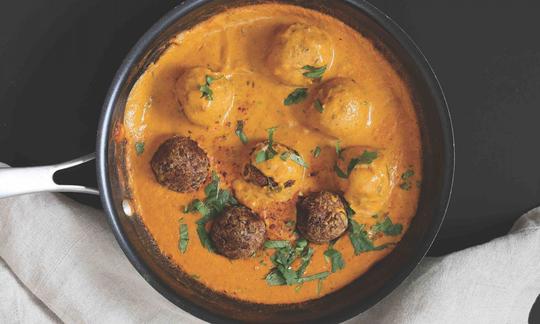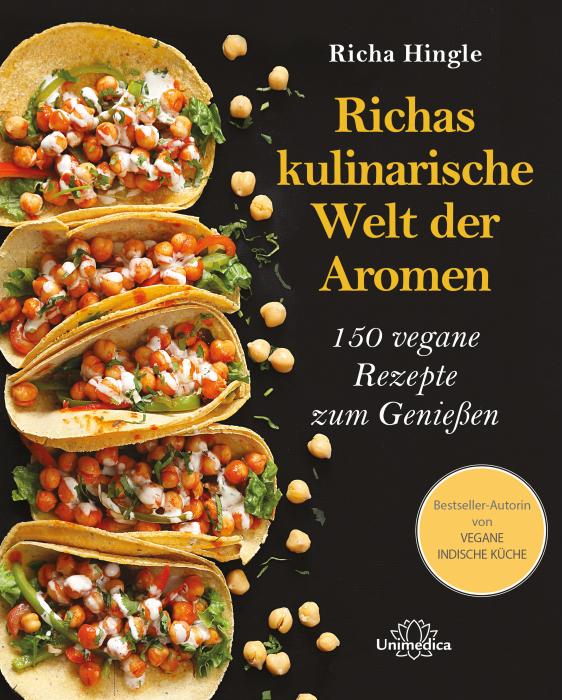Lentil dumplings with masala sauce, ginger and coriander
vegan
Ingredients (for servings, )
| For the flaxseed egg | |
|---|---|
| 1 tbsp, ground | Linseed, raw, organic? (golden linseed, flax) (0.25 oz) |
| 2 ½ tbsp | Drinking water, raw (organic?) (0.51 oz) |
| For the lentil dumplings | |
| 2 ⅛ oz | Onions, red, raw |
| 3 cloves | Garlic (organic?) (0.32 oz) |
| ½ cm | Ginger, raw (organic?) (0.19 oz) |
| 1 ⅜ oz | Walnuts (tree nuts), raw (organic?) |
| 2 tbsp | Coriander leaves, raw (0.05 oz) |
| 1 dash | Table salt (table salt, raw?, organic?) (0.01 oz) |
| ¾ tsp | Cumin, ground (raw, organic?) (0.08 oz) |
| ¾ tsp | Real coriander, seeds (raw?, organic?) (0.05 oz) |
| ½ tsp | Garlic granules (garlic powder, raw?, organic?) (0.05 oz) |
| ½ tsp | Cayenne pepper (raw?, organic?) (0.03 oz) |
| ½ tsp | Garam Masala (spice mix, raw?, organic?) (0.04 oz) |
| 5 ½ oz | Whole grain rice, long grain, cooked (organic?) |
| 11 oz | Lentils (cooking lentils, erve), cooked, without salt |
| 1 tsp | Lime juice (raw?, organic?) (0.09 oz) |
| 1 tsp | Safflower oil (raw?, organic?) (0.16 oz) |
| 3 tbsp | Wheat flour (raw?, organic?) (1.1 oz) |
| For the sauce | |
| 400 ml | Vegan Makhani Sauce (organic?) (16 oz) |
Equipment
- skillet (frying pan) or oven
- blender
- stove
- citrus juicer (lemon squeezer)
- saucepan
Type of preparation
- cook
- bake
- chop or grind
- blend
- squeeze
- meld
- bring to a boil
- sauté
- remove the skin
- peel
Preparation
For the flaxseed egg
In a small bowl, mix the ground flaxseed and water. Allow the mixture to sit at room temperature or in the refrigerator for 15 minutes before using.For the lentil dumplings
Peel and chop the onion, peel the garlic and peel the ginger. Finely chop the onion, garlic, ginger, walnuts and, if necessary, the fresh coriander in the food processor.Alternatively, fry the onions and garlic in a small pan in 1⁄2 teaspoon oil over medium heat until golden brown and then chop finely with the other ingredients.
For 4 servings, the author uses 0.6 cm of fresh, peeled ginger root.
Add the salt (if the lentils are not salted), cumin and coriander seeds, garlic powder, cayenne pepper, garam masala, cooked rice and 150g of the cooked lentils and pulse into the other ingredients until most of the lentils are chopped. Pour the mixture into a large bowl.
The original recipe uses ¾ teaspoon of salt for 4 servings. More information under "Tips".
The author recommends using cooked whole grain or white rice, preferably cooled, and cooked brown lentils (or 1 can (425 g) lentils, drained and rinsed), which are best prepared in advance.
Carefully mix in the remaining 150 g of lentils, lime juice (or ketchup), oil and the flaxseed egg (from step 1). Taste and adjust seasoning if necessary. Mix in the flour. Leave the mixture to rest in the fridge for 10-15 minutes.
Instead of flour, you can also use breadcrumbs or, for a gluten-free version, chickpea flour.
Check the consistency of the cooled mixture. If the mixture is still too moist, mix in a little more flour. How much flour is needed depends on the moisture content of the vegetables and lentils. If the mixture is too crumbly, mix in more flaxseed egg. When the mixture has the right consistency, form 3-4 cm balls out of it.
With the mixture for 4 portions you should get at least 16 balls.
Heat a large frying pan over a moderately high heat and cover the bottom of the pan with a thin layer of oil. Add the lentil dumplings (not all at once so the pan is not too full) and fry for 7-8 minutes until golden brown on all sides. Move the dumplings around in the pan every 2 minutes so that they cook evenly.
Alternatively, you can bake the lentil dumplings: Place them with some space between them on a baking tray lined with baking paper, spray with oil and then bake in an oven preheated to 190 °C for 20-22 minutes.
Completing the dish
Bring the makhani sauce to a gentle boil in a small saucepan over medium heat. (If the sauce is chilled and slightly thickened, add a little water.) Add the lentil dumplings to the sauce and let it simmer for 1-2 minutes. Serve immediately.
|
Nutritional Information per person
Convert per 100g
|
2000 kcal | |
|---|---|---|
| Energy | 346 kcal | 17.3% |
| Fat/Lipids | 14 g | 20.3% |
| Saturated Fats | 1.6 g | 8.1% |
| Carbohydrates (inc.dietary fiber) | 45 g | 16.7% |
| Sugars | 5.9 g | 6.5% |
| Fiber | 10 g | 40.9% |
| Protein/Albumin | 13 g | 26.9% |
| Cooking Salt (Na:85.0 mg) | 216 mg | 9.0% |
| Essential micronutrients with the highest proportions | per person | 2000 kcal | |
|---|---|---|---|
| Min | Manganese, Mn | 1.7 mg | 86.0% |
| Vit | Folate, as the active form of folic acid (née vitamin B9 and | 171 µg | 85.0% |
| Fat | Alpha-Linolenic acid; ALA; 18:3 omega-3 | 1.4 g | 68.0% |
| Min | Copper, Cu | 0.67 mg | 67.0% |
| Prot | Tryptophan (Trp, W) | 0.14 g | 56.0% |
| Fat | Linoleic acid; LA; 18:2 omega-6 | 5.2 g | 52.0% |
| Prot | Threonine (Thr, T) | 0.46 g | 49.0% |
| Elem | Phosphorus, P | 307 mg | 44.0% |
| Prot | Isoleucine (Ile, I) | 0.53 g | 43.0% |
| Prot | Phenylalanine (Phe, F) | 0.62 g | 40.0% |
Detailed Nutritional Information per Person for this Recipe
The majority of the nutritional information comes from the USDA (US Department of Agriculture). This means that the information for natural products is often incomplete or only given within broader categories, whereas in most cases products made from these have more complete information displayed.
If we take flaxseed, for example, the important essential amino acid ALA (omega-3) is only included in an overarching category whereas for flaxseed oil ALA is listed specifically. In time, we will be able to change this, but it will require a lot of work. An “i” appears behind ingredients that have been adjusted and an explanation appears when you hover over this symbol.
For Erb Muesli, the original calculations resulted in 48 % of the daily requirement of ALA — but with the correction, we see that the muesli actually covers >100 % of the necessary recommendation for the omega-3 fatty acid ALA. Our goal is to eventually be able to compare the nutritional value of our recipes with those that are used in conventional western lifestyles.
| Essential fatty acids | per person | 2000 kcal |
|---|---|---|
| Alpha-Linolenic acid; ALA; 18:3 omega-3 | 1.4 g | 68.0% |
| Linoleic acid; LA; 18:2 omega-6 | 5.2 g | 52.0% |
| Essential amino acids | per person | 2000 kcal |
|---|---|---|
| Tryptophan (Trp, W) | 0.14 g | 56.0% |
| Threonine (Thr, T) | 0.46 g | 49.0% |
| Isoleucine (Ile, I) | 0.53 g | 43.0% |
| Phenylalanine (Phe, F) | 0.62 g | 40.0% |
| Valine (Val, V) | 0.64 g | 40.0% |
| Leucine (Leu, L) | 0.92 g | 38.0% |
| Lysine (Lys, K) | 0.70 g | 38.0% |
| Methionine (Met, M) | 0.16 g | 17.0% |
| Vitamins | per person | 2000 kcal |
|---|---|---|
| Folate, as the active form of folic acid (née vitamin B9 and | 171 µg | 85.0% |
| Vitamin B6 (pyridoxine) | 0.48 mg | 34.0% |
| Thiamine (vitamin B1) | 0.35 mg | 32.0% |
| Vitamin C (ascorbic acid) | 14 mg | 17.0% |
| Niacin (née vitamin B3) | 2.6 mg | 16.0% |
| Pantothenic acid (vitamin B5) | 0.94 mg | 16.0% |
| Biotin (ex vitamin B7, H) | 8.1 µg | 16.0% |
| Vitamin E, as a-TEs | 1.8 mg | 15.0% |
| Vitamin K | 9.4 µg | 13.0% |
| Riboflavin (vitamin B2) | 0.15 mg | 11.0% |
| Vitamin A, as RAE | 30 µg | 4.0% |
| Essential macroelements (macronutrients) | per person | 2000 kcal |
|---|---|---|
| Phosphorus, P | 307 mg | 44.0% |
| Potassium, K | 699 mg | 35.0% |
| Magnesium, Mg | 104 mg | 28.0% |
| Sodium, Na | 85 mg | 11.0% |
| Calcium, Ca | 81 mg | 10.0% |
| Essential trace elements (micronutrients) | per person | 2000 kcal |
|---|---|---|
| Manganese, Mn | 1.7 mg | 86.0% |
| Copper, Cu | 0.67 mg | 67.0% |
| Iron, Fe | 5.1 mg | 36.0% |
| Zinc, Zn | 2.4 mg | 24.0% |
| Selenium, Se | 11 µg | 20.0% |
| Iod, I (Jod, J) | 2.5 µg | 2.0% |
| Fluorine, F | 28 µg | 1.0% |
Narayana Verlag GmbH /Unimedica Verlag , Richa Hingle
Raw recipes 12, Cooked recipes 142 (6)
Additional photos (10)
"Richa's Culinary World of Flavors - 150 Vegan Recipes to Enjoy" contains international, oriental-inspired, healthy dishes for every taste.
Since this book is written in German, a description is omitted here. If you are interested, please switch to German in the menu.
Garam masala, ginger, cumin and coriander give the lentil dumplings with masala sauce a special oriental taste.
Preparation time: The preparation time refers only to the preparation of the lentil dumplings. The preparation time for the makhani sauce and the cooking time for the rice and lentils is not included. It is best to prepare these in advance.
Nutrient profile: According to GDA guidelines, one portion of this recipe covers over ¾ of the daily requirement of folic acid and manganese. The dish also covers over half of the daily requirement of copper, tryptophan and alpha-linolenic acid (ALA). The ratio of omega-6 to omega-3 fatty acids is 3:1, within the recommended maximum ratio of 5:1. Through our optimization, we were able to reduce the salt content from 70% to 28% of the daily requirement.
Makhani Sauce: This is the butter sauce used as a basic sauce in most Indian restaurants – however, this version is lighter and does not contain any dairy products.
Garam Masala: This Indian spice mixture contains black cardamom, cinnamon, cloves, black pepper and cumin, among other things. Chili and coriander seeds are also often used. Unlike curry powder, it does not contain turmeric and tastes both more intense and more complex. You can buy garam masala as a spice mixture, usually in powder form, in Indian grocery stores, well-stocked supermarkets or online. Garam masala made from whole spices stays aromatic and fresh for longer. For a recipe for making your own spice mixture, please see the following link.
Flaxseed Egg: Ground flaxseed mixed under water creates a sticky mass that works well as a chicken egg substitute in baking and other recipes that require a binding agent, such as lentil or bean patties. However, a flaxseed egg is not a 1:1 substitute for a chicken egg in most recipes, especially in recipes that use multiple eggs.
Ginger: Ginger has an aromatic smell and a sharp, spicy taste, which is due to the substance gingerol, which is said to have anti-carcinogenic and anti-inflammatory effects. The substances borneol and cineol give ginger its digestive, antiemetic, appetite-stimulating and circulation-stimulating properties. The rhizome of ginger is used in cooking, in fresh, dried or ground form. The young harvested rhizomes are called green or young ginger. They have a much milder taste and are less woody.
Cumin: Despite the similar name, cumin is not closely related to caraway and also differs greatly in taste. Ground cumin has a fresh and slightly spicy aroma, which it owes to the cuminaldehyde contained in the essential oil.
Coriander seeds: Coriander seeds contain 60% of the oil contained in the plant. Among others, linalool and geraniol are particularly responsible for the pleasant smell of coriander seeds, which only becomes apparent after drying.
Keep the oil and salt content to a minimum and avoid processed products: To keep the oil content as low as possible, it is advisable to follow Richa Hingle's recommendations and not fry the garlic and onion. It is also advisable to prepare the lentil dumplings in the oven instead of in a pan.
We have reduced the salt content for health reasons. Since salt requirements vary from person to person, it is best for you to decide for yourself.
We generally recommend preparing all the ingredients yourself, including cooking the lentils and rice yourself rather than buying them pre-cooked. We also used lime juice instead of the ketchup alternative given.
For more information on this topic, please see the following link: Vegans often eat unhealthily. Avoidable nutritional errors.
Lentil dumplings crispy or pulled through:
I usually prepare the sauce while the lentils are cooling, so that the lentil dumplings are ready when the sauce is simmering, and then they can simply sit in the sauce for the last 2 minutes of cooking. Depending on how you prefer your lentil dumplings (crispy or streaked with sauce), you can serve them drizzled with sauce or just leave them to sit in the sauce for 1-2 minutes
Nut-free version: For nut-free lentil balls, simply use 4 additional tablespoons of cooked lentils + 2 tablespoons of oatmeal instead of the walnuts.
Gluten-free option: Take Use chickpea flour instead of flour or breadcrumbs for a gluten-free version.
Without Garam Masala: For non-Indian lentil dumplings, omit the garam masala and add 1 teaspoon (or more) of the Quick Italian Spice Blend (page 163) instead.
Milder version: Reduce the amount of cayenne pepper to ½ teaspoon or use ½ teaspoon of paprika powder instead of cayenne pepper.




